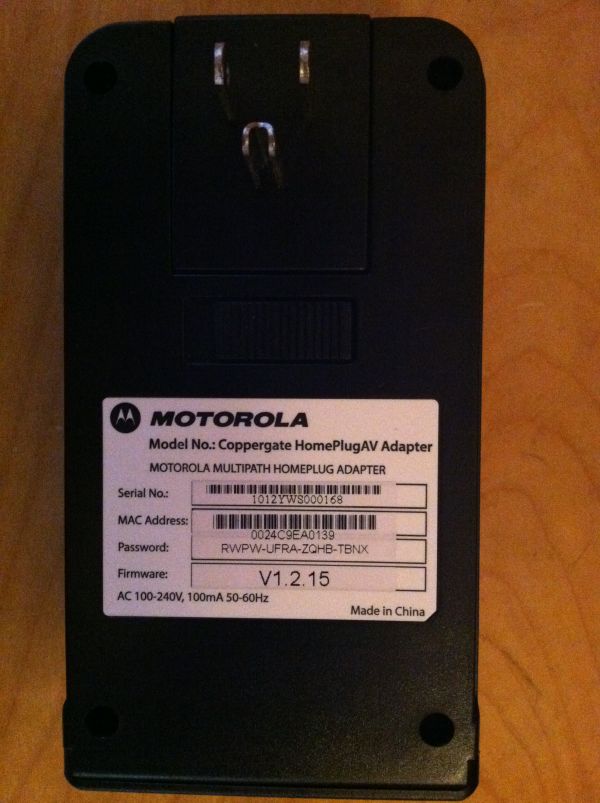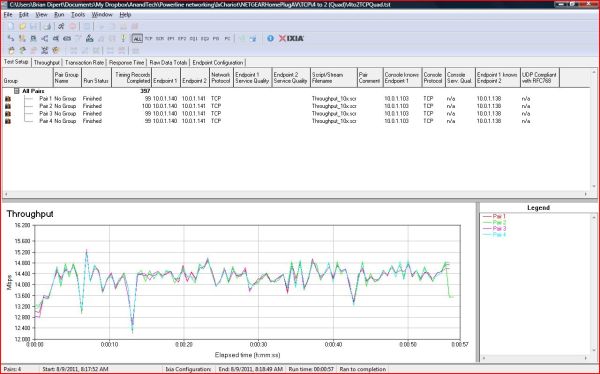Hands-On Powerline Networking: How Well (Or Not) Are Latest-Generation Devices Working?
by Brian Dipert on September 1, 2011 12:41 AM EST- Posted in
- Networking
- Powerline Adapters
- NetGear
Speaking of adapters, which ones received scrutiny in this study? The five 'base case' adapters were Netgear's XAV2001 HomePlug AV 200 units, which I made sure beforehand were upgraded to the latest-available v0.2.0.5NA firmware release, and are based on the Qualcomm third-generation INT6400 chipset:
Sigma Designs' CG2110 chipset was the foundation of the Motorola-branded (and Sigma Designs-supplied) second HomePlug AV adapter suite that I tested. These particular units offer three-prong power plugs, thereby at least conceptually implementing Sigma Designs' earlier-mentioned ClearPath technology for optionally routing powerline networking traffic over the earth ground connection:
Note that in this particular case, I was unfortunately only able to obtain three adapters from Sigma Designs, two of which I had connected to the powerline network nodes under test at any particular time, and the third mated to the router. The reason for mentioning this discrepancy will become clear in the next section of this article.
And at the performance high end, at least on paper, are Netgear's five XAV5001 IEEE 1901 adapters, derived from Qualcomm's latest-generation AR7400 chipset. As with the XAV2001s, I made sure that they were updated to the latest-available public firmware (v0.2.0.9NA in this particular case) before subjecting them to my barrage of tests:
Although at any particular point in time I was only measuring bandwidth between any two adapters, I had all of the adapters of any particular technology (five each for Netgear HomePlug AV and IEEE 1901, three for Sigma Designs/Motorola HomePlug AV) connected to the power grid at all times. As with my earlier description of static-vs-DHCP IP address assignments, this decision might not have enabled any particular adapter to operate at highest possible performance, because it was periodically (albeit briefly) interacting with all of its peers on the premises' power grid. However, such a setup more accurately mimics the way that powerline adapters will be operating in real-life usage settings, which is why I went this route (poor networking pun intended).
I harnessed the Ixia-supplied 'Throughput.scr' script, albeit customizing it to extend the test time by increasing the test-data payload size from 100 KBytes to 1 MByte. And, having learned through past testing situations that powerline adapters (and, more generally, all types of networking equipment) sometimes deliver higher aggregate throughput when more than one stream's worth of data is simultaneously flowing through them, I ran both one- and four-stream testing scenarios:














53 Comments
View All Comments
quiksilvr - Thursday, September 1, 2011 - link
Have you tried getting a better router and/or perhaps a better wireless card for your laptop?akedia - Thursday, September 1, 2011 - link
I have a current generation Airport Extreme, which is generally regarded as one of the best wireless routers available, and the built-in WiFi antenna in my Mac mini is not upgradable, as far as I know. My roommate's laptop is an HP dm1z, also not upgradable, and my Droid X is stuck with the antenna it shipped with as well. It's not my hardware, it's my environment. WiFi has limitations, like it or not.bdipert - Thursday, September 1, 2011 - link
Different tools for different tasks, jigglywiggly. Powerline can make a pretty good 'backbone' technology if, as I state in the article, you want to 'dispense with burrowing through dirty, spider- and snake-infested crawlspaces and drilling holes in walls and floors in order to route Cat5e cable around'. Wi-Fi conversely can be effective across intra-room and few-room spans...and with mobile devices.Paedric - Thursday, September 1, 2011 - link
Thanks for the article first, that's something I've been interested in for quite some time.However, I have a question; you tested it in a "perfect" environment by disabling interfering devices, to test the potential of the system, but what happen if it is not the case?
Is the performance hit really noticeable?
I don't want to rout a cable across the whole house, but I'm not really keen on turning off the fridge, lights, and unplugging devices every time I want to connect to the internet.
Denithor - Thursday, September 1, 2011 - link
I have the TRENDnet TPL-303E2K Powerline AV Adapter Kit installed in my home, connecting my wireless router in the living room to my office computer about 50 or 60 feet away. Couldn't get a solid enough wireless signal in the office for any kind of gaming, hooked up this kit and within literally 2 minutes was playing everything just fine.There's no need to unplug or turn off anything. It just works...
gariig - Thursday, September 1, 2011 - link
I bought my parents the same TRENDnet that Denithor has (crazy coincidence) because their wireless router and extra computer are on the other side of a ~2000 SQ FT house. Works flawlessly for normal computer usage (e-mail, Youtube, etc) and printer sharing. I don't know how well it works for large file transfers but I'd imagine you'll at least get 100 mbpsbdipert - Thursday, September 1, 2011 - link
It depends. That's the only meaningful answer I can offer. That's why, after much gnashing of teeth and back-and-forth waffling, I decided to do my testing with everything turned off and disconnected. Otherwise, if (say) I had an especially noisy refrigerator motor, my results might have unfairly undershot some alternative typical-refrigerator reality. Obviously, my data wasn't the absolute best case...as I mentioned, I stuck with DHCP address assignments for the two Endpoints, instead of hard-wiring static IP addresses, and I concurrently ran all available powerline networking adapters although only three were in active use at any point in time, and I chose outlets out of functional meaningfulness to me, intentionally ignoring whether or not they spanned multiple breakers, or jumped across phases, in the process. But I also don't think it would have been right to turn on all potential interference sources, then do the tests.With that said, I regularly sling ~20 Mbps Windows Media Center streams (HD ATSC recordings) around my LAN, including through powerline spans, with no problem.
leexgx - Thursday, September 1, 2011 - link
just would of been nice if you had done an short test with stuff on to see how it is handled them (just 1 page short tests) as you did it with every thing offyou could of had an laptop with you to monitor each power plug speeds when stuff came on, last power plugs I used the speeds stated seem close to bandwidth useable (-50 ish % for overhead)
I found power plugs to be very reliable and how they handle packet loss as well most of the time (last time I played with them)
Joe Martin - Thursday, September 1, 2011 - link
Does it work for streaming video or not? Very hard to read article.bdipert - Thursday, September 1, 2011 - link
It's impossible for me to provide a simple answer to such a question without either undershooting or overshooting the spectrum of possible realities. First off, there's the bandwidth potential of any two powerline nodes in YOUR particular setup to consider...only you can measure and ascertain that. Then you've gotta determine what you mean by 'streaming video'...are we talking about a 20 Mbps encapsulated MPEG-2 (ATSC) HD stream coming from a Windows Media Center server, for example, or a heavily compressed sub-1 Mbps H.264 standard-definition video stream? Protocol? Etc...